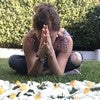Day 1: Align With You
Welcome to our first official day of the Self-Care Challenge. Hi. So happy you are here.
A Ritual for Beginning
The rhythm of practice reveals itself, sometimes slowly, sometimes quickly, but always… if we allow it. I’ve found that curating a few favorite practices and always beginning with them is a way to signal to myself that the practice is beginning. Coming back to the same assemblage of practices over time also reveals when and how I’ve changed as well as when and how my practice shifts and changes. For this immersion, I’d like to invite you to create your own ritual for beginning. Perhaps start with the clearing of space: both in place and in time. Light a candle or gaze at an inspiring photo. Anoint yourself with flower essences or essential oils. Do your thing. Then we’ll settle in for an opening chant.Togetherness Mantra
OM saha navavatu, saha nau bhunaktu Saha veeryam karvaavahai Tejasvi naa vadhita mastu maa vid vishaa va hai OM shanti, shanti, shanti. Sad guru nath maharaj ki-jay! May we be protected together; May we nourish each other; May we grow together; May we not grow to resent each other; OM peace peace peace! Victory to the true teachings.Non-violation, Ahimsa
We begin our work (as it tends to go in Yoga) with the most simple and most advanced practices. We begin at the end to prepare us to begin again over and over. Our work will follow the blueprint of the yamas and niyamas, these principles of honoring the divine in ourselves and in others, as described by the Yoga Sutras. We will use this framework to dive deeply into the care for and study of the self in order to achieve (or to remember) freedom. And this work begins and ends with ahimsa. Although ahimsa is often translated as non-violence, I love Ravi Ravindra’s use of the term non-violation to describe the essence of ahimsa. To practice ahimsa is to practice non-violation of the order of things. To practice remaining in synch with the cosmos. To be completely free in the flow of life. And this has a feeling in the body, a resonance. To begin to recognize it, however, requires us to also notice what it feels like to be out of synch, to be in violation. Luckily, we have many opportunities to do both. Our practice is a collection of moments where we notice what is actually happening. To truly practice ahimsa, to live your practice, it’s useful to get into the habit of asking yourself, “What do I feel right now? Where do I feel right now? What does it feel like?” Don’t worry if the answers wouldn’t make sense to anyone else. That is not their fate. There can be this temptation to dismiss ahimsa as simple, simplistic, not representing the deepest depths of practice, but truly, the whole of this practice begins and ends with ahimsa: a reverence for the gossamer matrix of this universe. When we begin to recognize it, we’ll find our way in faster, for longer and in deeper service to all. Join us for the 10 Day Self-Care Challenge with Kelly Sunrose.Comments
Skip to Latest
Sarasloves & Terry  Sorry for my slow reply! Thank you so much for being here and for engaging with this challenge. ALL LOVE.
Sorry for my slow reply! Thank you so much for being here and for engaging with this challenge. ALL LOVE.
 Sorry for my slow reply! Thank you so much for being here and for engaging with this challenge. ALL LOVE.
Sorry for my slow reply! Thank you so much for being here and for engaging with this challenge. ALL LOVE.
7 years ago
You need to be a subscriber to post a comment.
Please Log In or Create an Account to start your free trial.














